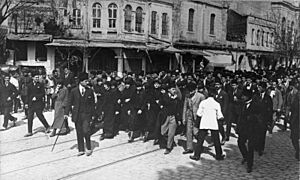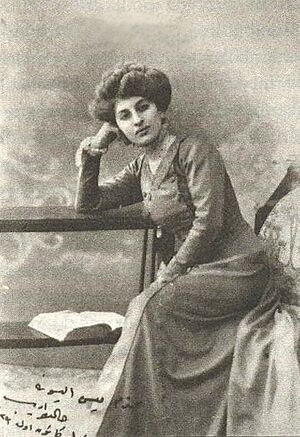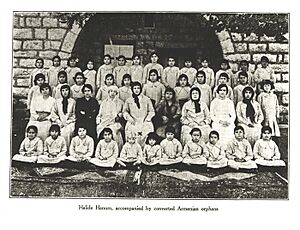Halide Edib Adıvar facts for kids
Quick facts for kids
Halide Edib Adıvar
|
|
|---|---|
 |
|
| Member of the Grand National Assembly | |
| In office 14 May 1950 – 5 January 1954 |
|
| Constituency | İzmir (1950) |
| Personal details | |
| Born | 11 June 1884 Constantinople, Ottoman Empire |
| Died | 9 January 1964 (aged 79) Istanbul, Turkey |
| Resting place | Merkezefendi Cemetery, Istanbul, Turkey |
| Citizenship | Turkey |
| Nationality | Turkish |
| Spouses | Salih Zeki Adnan Adıvar |
| Education | American College for Girls |
| Occupation | Novelist |
| Awards | Şefkat Nişanı |
Halide Edib Adıvar (Ottoman Turkish: خالده اديب, 11 June 1884 – 9 January 1964) was an important Turkish writer, teacher, and thinker. She was known for her novels that talked about the challenges faced by Turkish women. She also believed in Pan-Turkism, a movement that aimed to unite Turkic peoples.
Halide Edib Adıvar is also remembered for her work with children who lost their families during World War I. She helped run schools where these children were cared for and taught Turkish culture.
Contents
Early Life and Education
Halide Edib was born in Constantinople (now Istanbul) in the Ottoman Empire. Her father worked for the Ottoman sultan. Halide was taught at home by private tutors. She learned many subjects, including European and Ottoman literature, religion, philosophy, and languages like English, French, and Arabic. She even learned Greek from her neighbors.
She attended the American College for Girls in Istanbul. In 1897, she translated a book called Mother. For this work, the sultan gave her an award called the Order of Charity. She graduated from the American College in 1901. Her home was a place where many smart people gathered, and Halide joined in these discussions even as a child.
Early Career and Writings
After college, Halide married Salih Zeki Bey, a mathematician. They had two sons. She continued her studies and began writing articles in 1908. She wrote about education and the role of women for newspapers and women's magazines. Her first novel, Seviye Talip, was published in 1909.
Because of her articles, the education ministry hired her to improve girls' schools in Constantinople. She helped change school lessons and teaching methods. She also taught in various schools. She later left this job due to a disagreement about mosque schools.
She divorced Salih Zeki in 1910. Her house became a meeting place for people interested in new ideas about Turkish identity. In 1912, she became the first female member of the Turkish Hearths, a group promoting Turkish culture. She also helped start an organization called Elevation of Women.
During World War I
In 1917, Halide married Dr. Adnan Adıvar. The next year, she became a lecturer at Istanbul University. During this time, she became very active in Turkey's nationalist movement. She was inspired by the ideas of Ziya Gökalp, a famous Turkish thinker.
From 1916 to 1917, she worked as an inspector for schools in places like Damascus and Beirut. These schools included hundreds of children who had lost their families during the war. Many of these children were Armenian, Arab, and Kurdish. Under Halide Edib Adıvar's guidance, some of these children were taught Turkish culture and given new Turkish names.
An American observer at the time noted that Halide Edib was involved in teaching these children to become Turkish. Karnig Panian, who was a child in one of these orphanages, later wrote about his experiences. He said that children who spoke Armenian were sometimes punished. The goal was to help the children adapt to Turkish ways.
A priest at one of the colleges, Emile Joppin, wrote that Armenian orphans were given new Turkish or Arab names. An American Red Cross officer also reported that all signs of the children's original background were removed. They were given Turkish names and taught Turkish customs.
Some historians have compared this treatment of non-Turkish children to similar schools for Native American children in America and Canada. Halide Edib herself later wrote an article in 1918 condemning the massacres that had happened. She said, "We slaughtered the innocent Armenian population... We tried to extinguish the Armenians through methods that belong to the medieval times."
From 1919 to 1920, she wrote for a weekly magazine called Büyük Mecmua. This magazine supported the Turkish independence war.
During the War of Independence

After World War I, parts of the Ottoman Empire were taken over by Allied forces. Mustafa Kemal Atatürk began to organize a resistance movement. Halide Edib became known in Istanbul for her strong speeches. She spoke to thousands of people who were protesting the occupation of Smyrna by Greek forces.
Halide Edib and her husband left Istanbul to join the Turkish National Movement in Anatolia. On their way, she met another journalist, Yunus Nadi Abalıoğlu. They decided to start a news agency to share information about the Turkish War of Independence with the world. They named it "Anadolu Ajansı".
During the war, she served as a corporal and then a sergeant in the nationalist army. She visited the battlefronts and worked at the headquarters of İsmet Pasha. She wrote about her experiences and the destruction she saw in her book The Turkish Ordeal.
Life After the War

After the war, Halide Edib and her husband moved to Europe. They lived in France and the United Kingdom from 1926 to 1939. During this time, Halide Edib traveled a lot. She taught and gave lectures in the United States and India. She wrote about her experiences in India in her book Inside India.
She returned to Turkey in 1939 and became a professor of English literature at Istanbul University. In 1950, she was elected to the Turkish Parliament. She served until 1954. This was the only official political job she ever held.
Literature and Themes
Halide Edib's novels often featured strong, independent female characters. These characters worked hard to achieve their goals despite many challenges. She was also a strong Turkish nationalist. Many of her stories showed the important role of women in Turkey's fight for independence. She also wrote a thriller novel called Yolpalas Cinayeti (Murder in Yolpalas).
She was a supporter of Pan-Turkism and promoted Turanism in her books. Her book Yeni Turan (New Turan) suggested that Turkic peoples in Central Asia and the Caucasus should unite under an empire led by Turkey.
Death and Legacy
Halide Edib died on 9 January 1964 in Istanbul. She was buried in the Merkezefendi Cemetery in Istanbul.
Since the 1970s, the Ottoman and Turkish Studies Association has offered a scholarship named after Halide Edip Adıvar to students.
Major Works
- Seviye Talip (1910)
- Handan (1912)
- Yeni Turan (1912)
- Ateşten Gömlek (1922; translated as The Daughter of Smyrna or The Shirt of Flame)
- The Memoirs of Halide Edib (1926, in English)
- The Turkish Ordeal (1928, memoir, in English)
- Turkey Faces West (1930, in English)
- The Clown and His Daughter (1935, in English; later Sinekli Bakkal in Turkish, 1936)
- Inside India (1937, in English)
- Türk'ün Ateşle İmtihanı (1962, memoir; translated as House with Wisteria)
Images for kids










